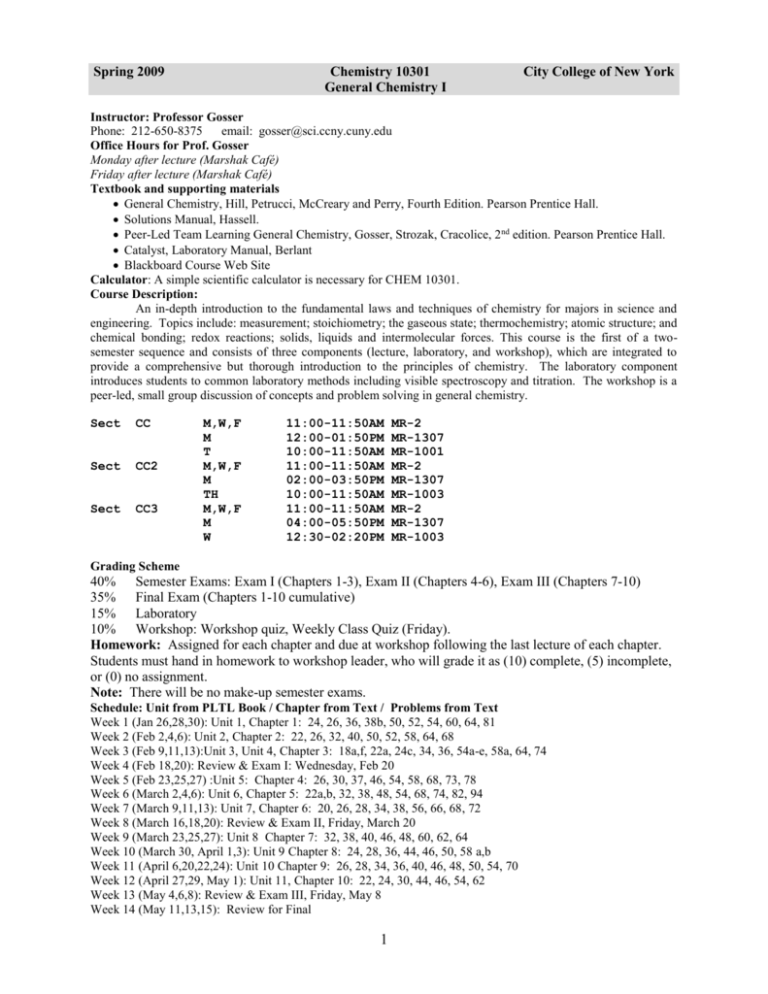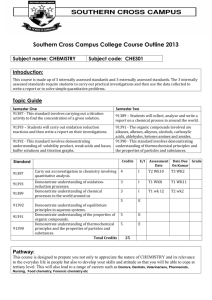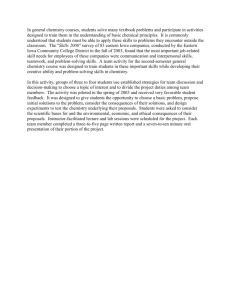
Spring 2009
Chemistry 10301
General Chemistry I
City College of New York
Instructor: Professor Gosser
Phone: 212-650-8375
email: gosser@sci.ccny.cuny.edu
Office Hours for Prof. Gosser
Monday after lecture (Marshak Café)
Friday after lecture (Marshak Café)
Textbook and supporting materials
General Chemistry, Hill, Petrucci, McCreary and Perry, Fourth Edition. Pearson Prentice Hall.
Solutions Manual, Hassell.
Peer-Led Team Learning General Chemistry, Gosser, Strozak, Cracolice, 2 nd edition. Pearson Prentice Hall.
Catalyst, Laboratory Manual, Berlant
Blackboard Course Web Site
Calculator: A simple scientific calculator is necessary for CHEM 10301.
Course Description:
An in-depth introduction to the fundamental laws and techniques of chemistry for majors in science and
engineering. Topics include: measurement; stoichiometry; the gaseous state; thermochemistry; atomic structure; and
chemical bonding; redox reactions; solids, liquids and intermolecular forces. This course is the first of a twosemester sequence and consists of three components (lecture, laboratory, and workshop), which are integrated to
provide a comprehensive but thorough introduction to the principles of chemistry. The laboratory component
introduces students to common laboratory methods including visible spectroscopy and titration. The workshop is a
peer-led, small group discussion of concepts and problem solving in general chemistry.
Sect
CC
Sect
CC2
Sect
CC3
M,W,F
M
T
M,W,F
M
TH
M,W,F
M
W
11:00-11:50AM
12:00-01:50PM
10:00-11:50AM
11:00-11:50AM
02:00-03:50PM
10:00-11:50AM
11:00-11:50AM
04:00-05:50PM
12:30-02:20PM
MR-2
MR-1307
MR-1001
MR-2
MR-1307
MR-1003
MR-2
MR-1307
MR-1003
Grading Scheme
40% Semester Exams: Exam I (Chapters 1-3), Exam II (Chapters 4-6), Exam III (Chapters 7-10)
35% Final Exam (Chapters 1-10 cumulative)
15% Laboratory
10% Workshop: Workshop quiz, Weekly Class Quiz (Friday).
Homework: Assigned for each chapter and due at workshop following the last lecture of each chapter.
Students must hand in homework to workshop leader, who will grade it as (10) complete, (5) incomplete,
or (0) no assignment.
Note: There will be no make-up semester exams.
Schedule: Unit from PLTL Book / Chapter from Text / Problems from Text
Week 1 (Jan 26,28,30): Unit 1, Chapter 1: 24, 26, 36, 38b, 50, 52, 54, 60, 64, 81
Week 2 (Feb 2,4,6): Unit 2, Chapter 2: 22, 26, 32, 40, 50, 52, 58, 64, 68
Week 3 (Feb 9,11,13):Unit 3, Unit 4, Chapter 3: 18a,f, 22a, 24c, 34, 36, 54a-e, 58a, 64, 74
Week 4 (Feb 18,20): Review & Exam I: Wednesday, Feb 20
Week 5 (Feb 23,25,27) :Unit 5: Chapter 4: 26, 30, 37, 46, 54, 58, 68, 73, 78
Week 6 (March 2,4,6): Unit 6, Chapter 5: 22a,b, 32, 38, 48, 54, 68, 74, 82, 94
Week 7 (March 9,11,13): Unit 7, Chapter 6: 20, 26, 28, 34, 38, 56, 66, 68, 72
Week 8 (March 16,18,20): Review & Exam II, Friday, March 20
Week 9 (March 23,25,27): Unit 8 Chapter 7: 32, 38, 40, 46, 48, 60, 62, 64
Week 10 (March 30, April 1,3): Unit 9 Chapter 8: 24, 28, 36, 44, 46, 50, 58 a,b
Week 11 (April 6,20,22,24): Unit 10 Chapter 9: 26, 28, 34, 36, 40, 46, 48, 50, 54, 70
Week 12 (April 27,29, May 1): Unit 11, Chapter 10: 22, 24, 30, 44, 46, 54, 62
Week 13 (May 4,6,8): Review & Exam III, Friday, May 8
Week 14 (May 11,13,15): Review for Final
1
After completing this course, students should be able to:
1. Perform unit conversions and express values with the correct number of significant figures.
2. Express and interpret atomic symbols, atomic number, mass number, and molar mass.
3. Understand and apply concepts of balancing chemical reactions, and be able to perform stoichiometric
calculations.
4. Define enthalpy and solve thermochemical equations.
5. Express quantum energy levels of atoms and relate these to atomic properties.
6. Draw and interpret Lewis-dot structures, predict three dimensional structure of simple molecules, and draw
simple molecular orbital diagrams.
7. Apply the ideal gas law to problems involving changes in moles, pressure, volume and temperature.
8. Solve problems involving solution chemistry such as titration and precipitation.
9. Write a laboratory report including data and analysis.
10. Be able to conduct a variety of experiments (titration, spectroscopic) including accurate recording of results
and preparation of calibration curves.
11. Be aware and follow the safety requirements in a chemical laboratory.
12. Analyze molecular modeling and graphic plots using computers.
13. Communicate concepts and problem solving of chemistry that have been presented in lecture.
14. Work as part of a problem solving team to solve chemistry problems.
15. Apply chemical principles to selected applications in life science or technology.
Topics covered:
1. Matter and Measurement
2. Atoms, Molecules, and Ions
3. Stoichiometry
4. Solution Chemistry
5. Gases
6. Thermochemistry
7. Quantum theory and the hydrogen atom 8. Electron-configuration & Periodicity
9. The Chemical Bond
10. Structure of Molecules
Study Guide:
1. Plan at least two hours of study (reading the chapter and completing the problem sets -“homework”) time
for every hour you spend in class.
2. Do the problem sets individually (without help from friends or classmates) initially. Please look at a
related problem in the solution manual to help you solve the assigned problem. If you are still unable to
solve the problem, then ask a friend, classmate, workshop leader, TA, or Professor for help.
3. Read the book and take notes as you read.
4. Attend workshop: finish the Self-Test, finish the workshop problems, and ask questions.
5. Seek help when you have difficulty (office hours, tutoring, study groups with workshop).
How to succeed in General Chemistry… or A word to the wise…
Learning Chemistry is cumulative – if you miss a class you will miss a significant building block, which
will affect your exam performance, scores, and final grade as well as your ability to understand material in future
courses. So, attendance for all lectures, labs, and workshops while required is critical to your success. Further, your
own practice by doing homework and becoming engaged with the material as well as engaged with your classmates
in workshop and lab discussions of chemical concepts will help you build your knowledge to succeed.
Statement on Academic Integrity
The CCNY policy on academic integrity will be followed in this course. The document can be found through the CCNY website by
clicking on Current Students Academic Services Policy on Academic Integrity. All students must read the details regarding
plagiarism and cheating in order to be familiar with the rules of the college. Cases where academic integrity is compromised will be
prosecuted according to these rules. In addition, the Policy of Academic Integrity can be found in the Undergraduate Bulletin 20072009 in Appendix B.3 on page 312.
Quotes to study by!
Everything should be as simple as it is, but not simpler
Albert Einstein
Mixing one's wines may be a mistake, but old and new wisdom mix admirably
Bertolt Brecht
How many legs does a dog have if you call the tail a leg? Four. Calling a tail a leg doesn't make it a leg
Abraham Lincoln
2








